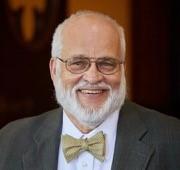Carl Grant is Dean (Interim) for the University of Oklahoma Libraries
In July 2018, astronomers announced that they had located a supermassive black hole at the center of the Milky Way Galaxy, our home galaxy. (Black holes are gravitational fields that have such intensity that when things enter, they disappear without a trace.) Which reminded me of a concern I’ve been voicing about digital preservation for the last several years, i.e., the fact that we have no apparent organized strategy for preserving cloud-based services.
A recent Gartner report forecasts continued average annual growth in excess of 20% for cloud computing. Even when it’s broken down into segments, Software-as-a-Service still shows annual growth in excess of 20%. (Note: With SaaS either all or important parts of the software solution are proprietary and running on hardware in the cloud, and that part is called Infrastructure-as-a-Service, i.e. IaaS). Here in our research library, that trend is certainly holding true. As a result, I see a perfect storm forming at the intersection of this lack of a cloud services digital preservation strategy and our work (and that of many other libraries) in the area of emerging technologies.
At our university library, we’re constantly trying to push the innovation boundaries by trying out new technologies and new ideas. Our Emerging Technologies Team does a lot of that type of work. The result of that trend has been some impressive achievements in the areas of artificial or virtual intelligence, robotics, cybersecurity, digital privacy, digital citizenship, blockchain, algorithm development, and 3D technologies, including devices that utilize 3D objects such as 3D printing, Augmented Reality, Virtual Reality and Mixed Reality. But here’s an important point: Many of those technologies are not stand-alone and are heavily dependent upon cloud-based services to support the rich functionality the product’s end-users experience.
As our teams have made those inroads in the utilization of these technologies in higher education, I keep asking the question: What are we doing to preserve our work so that future researchers, when writing the history of this work, will have the materials they will need in order to do so? The answers are vague at best and even worse, are getting more complicated by the day.
The answers can be bound up in commercial firms wishing to protect competitive advantages until they are exhausted. Even then, they’re not eager to share code. When vendors have been approached on the subject, they’ve been quick to say: “This is the responsibility of libraries” which then seemingly allows them to throw the ball over the fence and walk away w/o shouldering any of the responsibility.
It can also be bound up in the legal agreements that must be signed to use their products. Or the lack of backward compatibility with objects as new SaaS versions are released. All of this leaves many librarians thinking it will need to be be solved through legislation. But that seems extremely unlikely in the majority of the world’s current political environments. Some are considering Emulation-as-a-Service solutions, but these can be extremely costly for any one, or even a small number of institutions, to realistically contemplate. And the list goes on and on.
Our institution has resorted to trying to record videos of the end-user experience, capturing public documentation/manuals about the products and certainly, in many cases, the digital objects that were utilized in those experiences. But to say that leaves a massive black hole in the middle of our digital preservation strategy would be a kind understatement. Future researchers, attempting to research the backgrounds of these technologies, are going to judge us as massively incompetent. They will have good reason.
I know digital preservation of cloud-based products is incredibly hard. I truly understand many of the issues we’re up against. But I also remember (because I’m not young) a powerful moment when President John F. Kennedy stated, setting the U.S. on the path to visit the moon: “We choose to go to the Moon in this decade and do the other things, not because they are easy, but because they are hard; because that goal will serve to organize and measure the best of our energies and skills, because that challenge is one that we are willing to accept, one we are unwilling to postpone, and one we intend to win, and the others, too.”
Like President Kennedy, I believe these are problems we can overcome and that we owe it to future generations of researchers to do so. But as was true then and is certainly true of this challenge, we need to organize among ourselves because we can’t solve it operating independently; we need to see this as something we must do together in order to win. Cloud-computing is growing rapidly, and it seems we’re all focused on digital preservation strategies that, while important, aren’t addressing the cloud computing component, and thus will be rendered largely meaningless by the lack of the cloud computing component.
Are we waiting for the massive black hole to consume us? Really?
